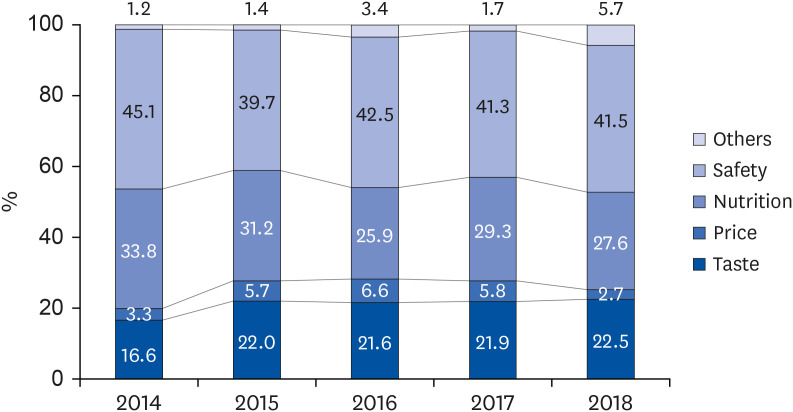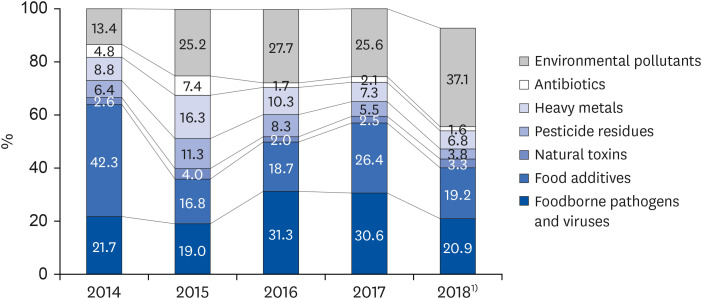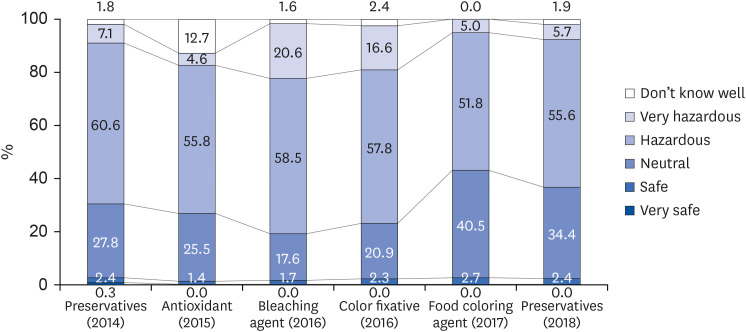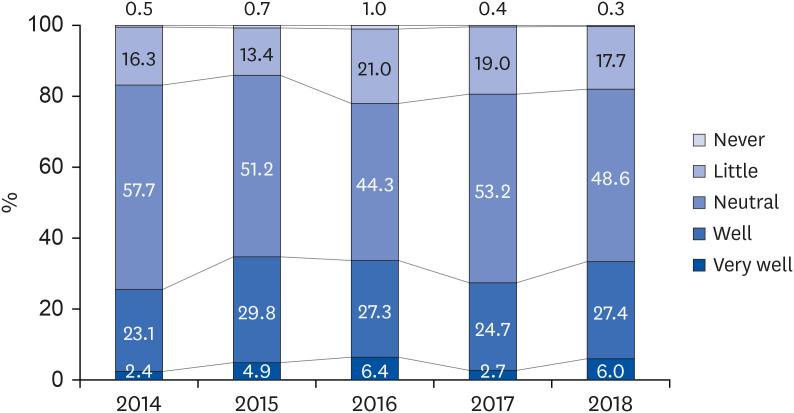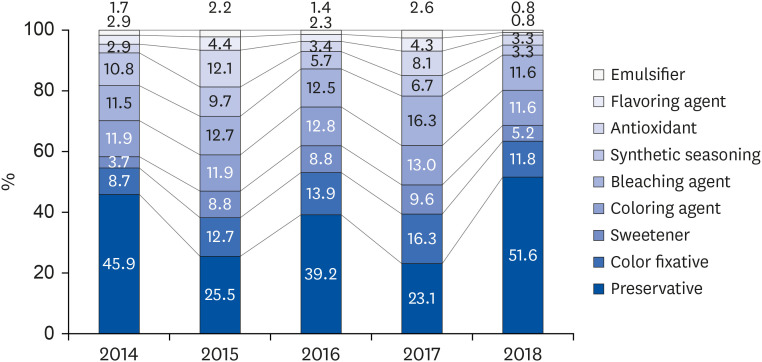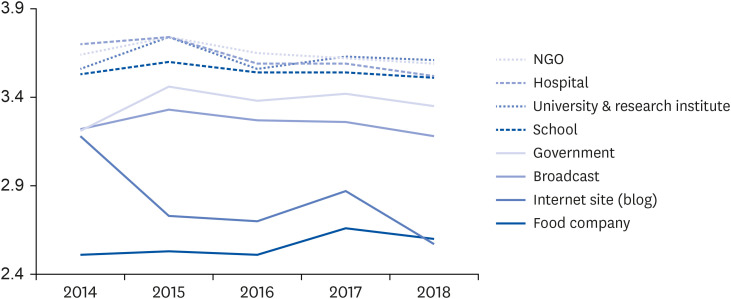Nutr Res Pract.
2021 Jun;15(3):346-354. 10.4162/nrp.2021.15.3.346.
Trends in Korean parents' perceptions on food additives during the period 2014–2018
- Affiliations
-
- 1Department of Nutrition Education, Graduate School of Education, Myongji University, Seoul 03674, Korea
- 2Division of Food and Nutrition in Human Ecology, Korea National Open University, Seoul 03087, Korea
- 3Department of Science & Technology Education for Life, Seoul National University of Education, Seoul 06639, Korea
- KMID: 2516073
- DOI: http://doi.org/10.4162/nrp.2021.15.3.346
Abstract
- BACKGROUND/OBJECTIVES
While the use of food additives in food processing has become a common practice worldwide, consumers' worry about potential hazards has not diminished. The purpose of this study was to identify trends in South Korean parents' perceptions about food additives by analyzing the results of surveys conducted from 2014 to 2018.
SUBJECTS/METHODS
We conducted an off-line survey in Korea annually between 2014 and 2018 on perceptions about food additives. The numbers of survey respondents in each year from 2014 to 2018 were 381, 426, 301, 519, and 369, respectively. Our consumer respondents were parents of elementary-school-aged children.
RESULTS
The ratios of respondents perceiving “food safety” as the most important factor in purchasing processed foods and “food additives” as the biggest threat to food safety have decreased over the years. However, most consumers still have negative perceptions of food additives. Additionally, among consumers lower confidence in or trust of the Korean government continued throughout the study period and appeared to be the main problem that needs to be overcome.
CONCLUSIONS
This study found that Korean parents are still troubled by food additives. Consumers' confidence in the government needs to be increased through public communications. More multifaceted educational programs communicating scientific knowledge of food additives are needed in order to correct consumers' misperceptions.
Keyword
Figure
Reference
-
1. Nurhan U. Consumer food safety knowledge and practices in the home in Turkey. Food Control. 2007; 18:45–51.
Article2. Emerton V, Choi E. Essential Guide to Food Additives. Cambridge: Leatherhead Food International, Royal Society of Chemistry;2008. p. 1–21.3. Branen AL, Davidson PM, Salminen S, Thorngate JH. Food Additives. New York (NY): Marcel Dekker;2002.4. Bearth A, Cousin ME, Siegrist M. The consumer's perception of artificial food additives: Influences on acceptance, risk and benefit perceptions. Food Qual Prefer. 2014; 38:14–23.
Article5. Floros JD, Newsome R, Fisher W, Barbosa-Cánovas GV, Chen H, Dunne CP, German JB, Hall RL, Heldman DR, Karwe MV, Knabel SJ, Labuza TP, Lund DB, Newell-McGloughlin M, Robinson JL, Sebranek JG, Shewfelt RL, Tracy WF, Weaver CM, Ziegler GR. Feeding the world today and tomorrow: the importance of food science and technology. Compr Rev Food Sci Food Saf. 2010; 9:572–599. PMID: 33467827.
Article6. Back BS, Lee YH. Consumer's awareness and policies directions on food additives-focusing on consumer information. J Consum Stud. 2006; 17:133–150.7. Kim HC, Kim MR. Consumer's recognition and information need about food safety. Korean J Diet Cult. 2001; 16:296–309.8. Korea Food and Drug Administration. Dietary Intake of Food Additive by Korean Population. Annual Report. Seoul: Korea Food and Drug Administration;2008.9. Shim SM, Seo SH, Lee Y, Moon GI, Kim MS, Park JH. Consumers' knowledge and safety perceptions of food additives: evaluation on the effectiveness of transmitting information on preservatives. Food Control. 2011; 22:1054–1060.
Article10. So YJ, Kim S, Lee JH, Park EY, Kim HJ, Kim JS, Kim JW. A survey on the perceptions of consumer organizations to promote risk communication for food additives. Korean J Food Cookery Sci. 2013; 29:105–113.
Article11. Kim JW. Development educational material for understanding of food additives. Safety Re-evaluation of Food Additives-about 32 Items Contain Colors. KFDA Research Report. Cheongju: Korea Health Industry Development Institute;2013. p. 537–647.12. Kim KD, Lee JY. A survey on the housewives' purchasing behavior and needs for food safety information. J Korean Soc Food Sci Nutr. 2010; 39:392–398.
Article13. Kim S, Kim JS, Ko JM, Kim JW. Trends of perception and information needs on food additives of children and parents by analyzing the safety assessment reports of food additives in 2008–2013. Korean J Food Cookery Sci. 2014; 30:249–261.
Article14. Ministry of Food and Drug Safety. Notification No. 2016-32 [Internet]. Cheongju: Ministry of Food and Drug Safety;2016. cited 2016 April 29. Available from: http://www.mfds.go.kr/index.do?mid=686&seq=10647.15. Kim S, Kim JS, Kang HJ, Lee G, Lim HS, Yun SS, Kim JW. Changes in Korean consumers' perception on food preservatives by a risk communication booklet. J Food Hyg Saf. 2018; 33:417–426.
Article16. International Food Information Council (IFIC) Foundation. 2019 Food and Health Survey [Internet]. Washington, D.C.: International Food Information Council;2019. cited 2019 May 22. Available from: https://foodinsight.org/2019-food-and-health-survey.17. Kang HJ, Kim S, Lee G, Lim HS, Yun SS, Kim JW. Perception gaps on food additives among various groups in Korea: food experts, teachers, nutrition teachers, nongovernmental organization members, and general consumers. J Food Prot. 2017; 80:1015–1021. PMID: 28504615.
Article18. Song M, IM M. The halo effect of additive-free claims in food and consumer goods. Korean J Consum Advert Psychol. 2016; 17:199–222.19. Brockman C, Beeren CJ. Additives in dairy foods: consumer perceptions of additives in dairy products. In : Fuquay JW, Fox PF, McSweeney PLH, editors. Encyclopedia of Dairy Sciences. Amsterdam: Academic Press;2011. p. 41–48.20. Lee JY, Han DB, Nayga RM Jr, Lim SS. Valuing traceability of imported beef in Korea: an experimental auction approach. Aust J Agric Resour Econ. 2011; 55:360–373.
Article21. Zhong Y, Wu L, Chen X, Huang Z, Hu W. Effects of food-additive-information on consumers' willingness to accept food with additives. Int J Environ Res Public Health. 2018; 15:e2394. PMID: 30380630.
Article22. Chen S, Lu X, Wu H, Zhong K, Guo L, Zhao J, Luo X. College student's perception of the safety risks of food additives and its main influencing factors. Food Sci. 2014; 35:245–249.23. Chen S, Wu H, Lu X, Zhong K, Xie X, Li X, Luo X, Guo L. The public's risk perception on food additives and the influence factors. J Chin Inst Food Sci Technol. 2015; 15:151–157.24. Wu L, Zhong Y, Shan L, Qin W. Public risk perception of food additives and food scares. The case in Suzhou, China. Appetite. 2013; 70:90–98. PMID: 23831014.
Article25. Rimal A, Fletcher SM, McWatters KH, Misra SK, Deodhar S. Perception of food safety and changes in food consumption habits: a consumer analysis. Int J Consum Stud. 2001; 25:43–52.
Article26. Frewer LJ, Fischer AR, Brennan M, Bánáti D, Lion R, Meertens RM, Rowe G, Siegrist M, Verbeke W, Vereijken CM. Risk/benefit communication about food-a systematic review of the literature. Crit Rev Food Sci Nutr. 2016; 56:1728–1745. PMID: 25575335.
Article27. Aoki K, Shen J, Saijo T. Consumer reaction to information on food additives: evidence from an eating experiment and a field survey. J Econ Behav Organ. 2010; 73:433–438.
Article28. Choi S, Lee J, Park E, Won J, Hong K, Moon G, Kim M, Hong J. Assessment of estimated daily intakes of preservatives in the Korean population. Korean J Food Sci Technol. 2008; 40:503–509.29. Ministry of Food and Drug Safety. Safety Evaluation of Food Additives. Annual Report. Cheongju: Ministry of Food and Drug Safety;2018.30. International Food Information Council (IFIC) Foundation. 2014 Food and Health Survey [Internet]. Washington, D.C.: International Food Information Council;2014. cited 2014 April 1. Available from: https://foodinsight.org/2014-food-and-health-survey.
- Full Text Links
- Actions
-
Cited
- CITED
-
- Close
- Share
- Similar articles
-
- A Study on the Parents' Perceptions of Children's Favorite Foods
- Development of Risk Communication Strategy and Educational Homepage on Food Additives
- Allergic Diseases in Childhood and Food Additives
- Developing educational programs to increase awareness of food additives among elementary school students
- Dietary Habits and Perception Toward Food Additives according to the Frequency of Consumption of Convenience Food at Convenience Stores among University Students in Cheongju

